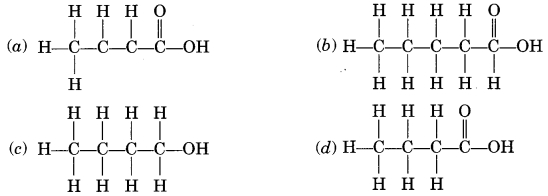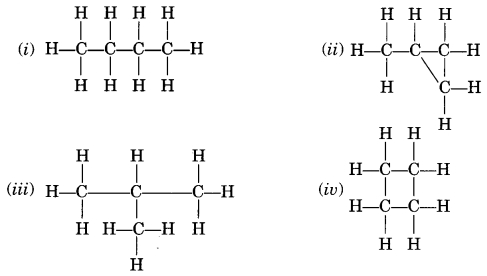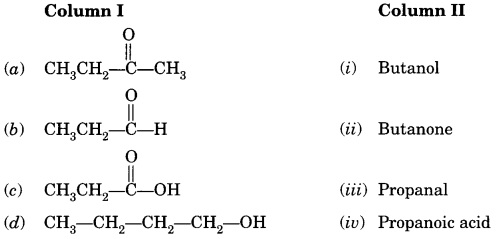Check the below NCERT MCQ Questions for Class 10 Science Chapter 4 Carbon and Its Compounds with Answers Pdf free download. MCQ Questions for Class 10 Science with Answers were prepared based on the latest exam pattern. We have Provided Carbon and Its Compounds Class 10 Science MCQs Questions with Answers to help students understand the concept very well. https://mcqquestions.guru/mcq-questions-for-class-10-science-chapter-4/
You can refer to NCERT Solutions for Class 10 Science Chapter 4 Carbon and Its Compounds to revise the concepts in the syllabus effectively and improve your chances of securing high marks in your board exams.
Carbon and Its Compounds Class 10 MCQs Questions with Answers
Question 1.
Carbon exists in the atmosphere in the form of
(a) carbon monoxide only
(b) carbon monoxide in traces and carbon dioxide
(c) carbon dioxide only
(d) coal
Answer
Answer: (b) carbon monoxide in traces and carbon dioxide
Question 2.
Graphite is used as a lubricant in machines because
(a) it is a good conductor of electricity.
(b) it has a high melting point and slippery layers.
(c) its density ranges from 1.9 to 2.3 g/cm3.
(d) it is strong and soft.
Answer
Answer: (b) it has a high melting point and slippery layers.
Question 3.
The allotrope of carbon which is a good conductor of heat and electricity is
(a) diamond
(b) graphite
(c) charcoal
(d) none of these
Answer
Answer: (b) graphite
Question 4.
Which of the following does not belong to the same homologous series?
(a) CH4
(b) C2H6
(c) C3H8
(d) C4H8
Answer
Answer: (d) C4H8
Question 5.
Which of the following is not considered as crystalline allotrope of carbon?
(a) Coal
(b) Diamond
(c) Graphite
(d) Fullerence
Answer
Answer: (a) Coal
Question 6.
Which form of carbon is found in Golkonda mines of Karnataka?
(a) Diamond
(b) Graphite
(c) Coal
(d) Coke
Answer
Answer: (a) Diamond
Question 7.
Lead pencil contains
(a) graphite
(b) diamond
(c) lead
(d) lead sulphate
Answer
Answer: (a) graphite
Question 8.
Mineral acids are stronger acids than carboxylic acids because
(i) mineral acids are completely ionised
(ii) carboxylic acids are completely ionised
(iii) mineral acids are partially ionised
(iv) carboxylic acids are partially ionised
(a) (i) and (iv)
(b) (ii) and (iii)
(c) (i) and (ii)
(d) (iii) and (iv)
Answer
Answer: (a) (i) and (iv)
Question 9.
When ethyl alcohol and acetic acid are mixed, the resulting ester has a chemical formula
(a) CH3COOC2H5
(b) C2H5COOCH3
(c) C2H5COOC2H5
(d)CH3COOCH3
Answer
Answer: (a) CH3COOC2H5
Question 10.
A few drops of ethanoic acid were added to solid sodium carbonate. The observation made was that
(a) a hissing sound was produced
(b) brown fumes evolved
(c) brisk effervescence occurred
(d) a pungent smelling gas evolved
Answer
Answer: (c) brisk effervescence occurred
Question 11.
A reagent which can help us to distinguish between alkenes and alkynes is:
(a) Bromine water
(b) Carbon tetrachloride
(c) Alkaline KMnO4
(d) Ammoniacal cuprous chloride
Answer
Answer: (d) Ammoniacal cuprous chloride
Question 12.
The correct structural formula of butanoic acid is

Answer
Answer: (d)
Question 13.
The soap molecule has a
(a) hydrophilic head and a hydrophobic tail
(b) hydrophobic head and a hydrophilic tail
(c) hydrophobic head and a hydrophobic tail
(d) hydrophilic head and a hydrophilic tail
Answer
Answer: (a) hydrophilic head and a hydrophobic tail
Question 14.
Detergents can be used for washing of clothes
(a) only in hard water
(b) only in soft water
(c) both in soft and hard water
(d) None of the above
Answer
Answer: (c) both in soft and hard water
Question 15.
Which among the following are unsaturated hydrocarbons?

(a) (i) and (iii)
(b) (ii) and (iii)
(c) (ii) and (iv)
(d) (iii) and (iv)
Answer
Answer: (c) (ii) and (iv)
Question 16.
Acetic acid was added to a solid X kept in a test tube. A colourless, odourless gas Y was evolved. The gas was passed through lime water, which turned milky. It was concluded that
(a) solid X is sodium hydroxide and the gas Y is CO2
(b) solid X is sodium bicarbonate and the gas Y is CO2
(c) solid X is sodium acetate and the gas Y is CO2
(d) solid X is sodium bicarbonate and the gas Y is SO2.
Answer
Answer: (b) solid X is sodium bicarbonate and the gas Y is CO2
Question 17.
Structural formula of ethyne is

Answer
Answer: (a)
Question 18.
A student while observing the properties of acetic acid would report that this smells like
(a) vinegar and turns red litmus blue
(b) rotten egg and turns red litmus blue
(c) vinegar and turns blue litmus red
(d) rotten egg and turns blue litmus red
Answer
Answer: (c) vinegar and turns blue litmus red
Question 19.
![]()
In the above given reaction, alkaline KMnO4 acts as
(a) reducing agent
(b) oxidising agent
(c) catalyst
(d) dehydrating agent
Answer
Answer: (b) oxidising agent
Question 20.
Vinegar is a solution of
(a) 50% – 60% acetic acid in alcohol
(b) 5% – 8% acetic acid in alcohol
(c) 5% – 8% acetic acid in water
(d) 50% – 60% acetic acid in water
Answer
Answer: (c) 5% – 8% acetic acid in water
Question 21.
The portion left on dropping a hydrogen atom from an alkane is called
(a) functional group
(b) alkenyl group
(c) alkyl group
(d) phenyl group
Answer
Answer: (c) alkyl group
Question 22.
The functional group present in a carboxylic acid is

Answer
Answer: (b)
Question 23.
Identify the unsaturated compounds from the following:
(i) Propane
(ii) Propene
(iii) Propyne
(iv) Chloropropane
(a) (i) and (ii)
(b) (ii) and (iv)
(c) (iii) and (iv)
(d) (ii) and (iii)
Answer
Answer: (d) (ii) and (iii)
Question 24.
Which of the following are correct structural isomers of butane?

(a) (i) and (iii)
(b) (ii) and (iv)
(c) (i) and (ii)
(d) (iii) and (iv)
Answer
Answer: (c) (i) and (ii)
Question 25.
Carbon forms four covalent bonds by sharing its four valence electrons with four univalent atoms, e.g., hydrogen. After the formation of four bonds, carbon attains the electronic configuration of
(a) helium
(b) neon
(c) argon
(d) krypton
Answer
Answer: (b) neon
Question 26.
Which of the following statements are usually correct for carbon compounds? These
(i) are good conductors of electricity
(ii) are poor conductors of electricity
(iii) have strong forces of attraction between their molecules
(iv) do not have strong forces of attraction between their molecules
(a) (i) and (iii)
(b) (ii) and (iii)
(c) (i) and (iv)
(d) (ii) and (iv)
Answer
Answer: (d) (ii) and (iv)
Question 27.
Pentane has the molecular formula C5H12. It has
(a) 5 covalent bonds
(b) 12 covalent bonds
(c) 16 covalent bonds
(d) 17 covalent bonds
Answer
Answer: (c) 16 covalent bonds
Question 28.
How many electrons are there in the outermost orbit of carbon?
(a) Two
(b) Three
(c) One
(d) Four
Answer
Answer: (d) Four
Question 29.
Which of these is true for most of the organic compounds?
(a) High melting and boiling points
(b) Low melting point but high boiling point
(c) High melting point but low boiling point
(d) Low melting and boiling points
Answer
Answer: (b) Low melting point but high boiling point
Question 30.
Hydrocarbons are mainly composed of which of these?
(a) Hydrogen, carbon and nitrogen
(b) Hydrogen and carbon
(c) Hydrogen
(d) Hydrogen, oxygen and carbon
Answer
Answer: (b) Hydrogen and carbon
Question 31.
How many double bonds are there in a saturated hydrocarbon?
(a) One
(b) Two
(c) Three
(d) Zero
Answer
Answer: (d) Zero
Question 32.
Successive members of a homologous series vary by how many atomic mass unit?
(a) Sixteen
(b) Fourteen
(c) One
(d) Twelve
Answer
Answer: (b) Fourteen
Question 33.
Ethanol is also known as which of these?
(a) Formic acid
(b) Ethyl alcohol
(c) Ethane
(d) Acetaldehyde
Answer
Answer: (b) Ethyl alcohol
Question 34.
Ethanoic acid is also known as which of these?
(a) Citric acid
(b) Nitric acid
(c) Acetic acid
(d) Formic acid
Answer
Answer: (c) Acetic acid
Question 35.
Soaps are ester of which type of acids?
(a) Formic acid
(b) Fatty acid
(c) Inorganic acid
(d) Acetic acid
Answer
Answer: (b) Fatty acid
Question 36.
Which of these is not an organic acid?
(a) Acetic acid
(b) Tartaric acid
(c) Nitric acid
(d) Formic acid
Answer
Answer: (c) Nitric acid
Question 37.
Which of the following is not an allotropic form of carbon?
(a) Fluorine
(b) Fullerene
(c) Diamond
(d) Graphite
Answer
Answer: (a) Fluorine
Fill in the blanks
Choosing only words from the following list, write down the appropriate words to fill in the blanks from (i) to (vi) given below.
Addition, carbohydrates, CnH2n-2, CnH2n, CnH2n+2, electrochemical, homologous, hydrocarbons, saturated substitution, unsaturated, methane, nickel.
The alkanes form a (i) ………….. series with the general formula (ii) ………….. The alkanes are (iii) ………….. (iv) ………….. which generally undergo (v) ………….. reactions. First homologue of this series is named as ………….. (vi).
Answer
Answer:
(i) homologous
(ii) CnH2n+2
(iii) saturated
(iv) hydrocarbons
(v) substitution
(vi) methane
Give One word Answers for the following:
1. A gas which is also known as marsh gas.
Answer
Answer: Methane
2. Catalyst used to convert alkanes to aldehydes.
Answer
Answer: Molybdenum oxide
3. Used for making pickles and preservatives.
Answer
Answer: Vinegar
4. The category of compounds with -COOH as functional groups.
Answer
Answer: Carboxylic acid
5. The category of compounds with OH as functional group.
Answer
Answer: Alcohol
6. A white solid which on treatment with water liberates acetylene.
Answer
Answer: Calcium carbide
7. A reagent which can be used to distinguish between ethene and ethyne.
Answer
Answer: Ammoniacal cuprous chloride
8. A gas used for artificial ripening of fruits.
Answer
Answer: Ethene / Ethyne
9. A solution used to store biological specimen.
Answer
Answer: Formalin
10. Organic acid present in vinegar.
Answer
Answer: Acetic acid
11. The process by which bigger hydrocarbons split into smaller hydrocarbons.
Answer
Answer: Pyrolysis
12. The process by which hydrogen converts unsaturated compounds to saturated compounds.
Answer
Answer: Hydrogenation
13. The process of removal of water from organic compounds.
Answer
Answer: Dehydration
14. Ethyl alcohol containing methanol is known as
Answer
Answer: Spurious liquor
15. A gas prepared when ethyl alcohol is treated with concentrated sulphuric acid.
Answer
Answer: Ethene
Match the following columns
1.

Answer
Answer:
(a) – (iv)
(b) – (i)
(c) – (ii)
(d) – (iii)
2.

Answer
Answer:
(a) – (iv)
(b) – (iii)
(c) – (ii)
(d) – (i)
3.

Answer
Answer:
(a) – (ii)
(b) – (iii)
(c) – (iv)
(d) – (i)
4.

Answer
Answer:
(a) – (iii)
(b) – (i)
(c) – (iv)
(d) – (ii)
Complete the crossword below.

Across
3. First homologue of alkene series
5. The organic compounds having the same molecular formula but different structures
6. Allotrope of carbon used as glass cutter
8. Compounds of carbon and hydrogen
Down:
1. Organic compound formed by reaction of acid and alcohol
2. Self linking ability of carbon
4. Substance which has cleansing action in hard water
7. Allotrope of carbon used in lubrication
Answer
Answer:
Across:
3. Ethene
5. Isomers
6. Diamond
8. Hydrocarbons
Down:
1. Ester
2. Catenation
4. Detergent
7. Graphite
We hope the given NCERT MCQ Questions for Class 10 Science Chapter 4 Carbon and Its Compounds with Answers Pdf free download will help you. If you have any queries regarding Carbon and Its Compounds CBSE Class 10 Science MCQs Multiple Choice Questions with Answers, drop a comment below and we will get back to you soon.